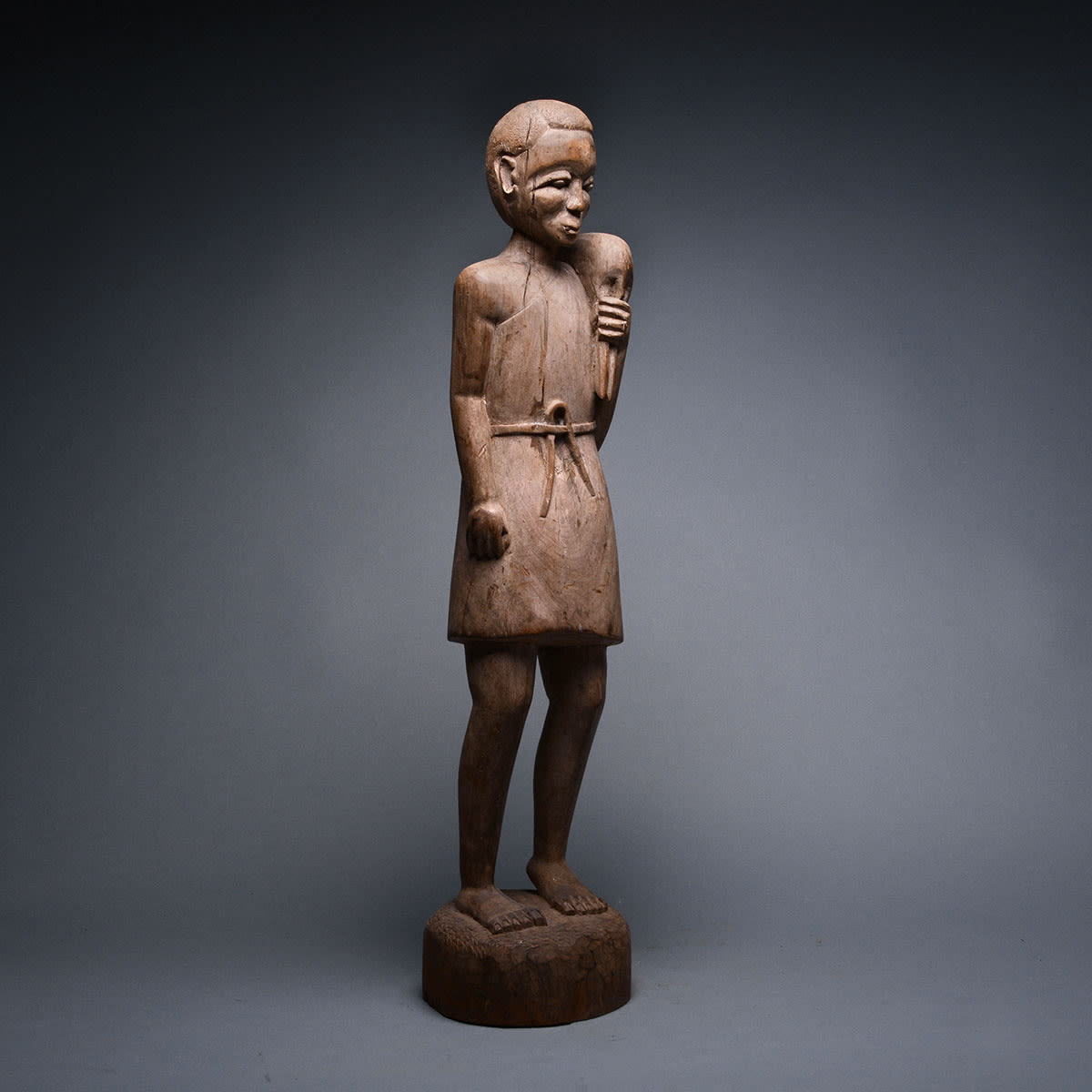Bambara Wooden Sculpture of Christ, 20th Century CE
Wood
87 x 16.5 cm
34 1/4 x 6 1/2 in
34 1/4 x 6 1/2 in
PF.4163 (LSO)
Further images
This serene piece is said to represent Jesus, and this perfectly illustrates the Christianisation of Africa, as well as the fusion of western religion and African aesthetics. It differs strongly...
This serene piece is said to represent Jesus, and this perfectly illustrates the Christianisation of Africa, as well as the fusion of western religion and African aesthetics. It differs strongly from traditional Bambara representations and also from their colonial works. It represents a boy of African appearance – interestingly – with a short tunic tied around the waist with a thong. He is carrying a lamb over his left shoulder, and is gracefully bearing his weight on his left foot. The features are placid and tranquil, and a small hole in his right fist suggests that he once held something, such as a crook.
The Bambara/Bamana is one of the largest groups in Mali (about 2.5 million) and lives in a savannah grassland area that contrasts strongly with the Dogon heartland. Their linguistic heritage indicates that they are part of the Mande group, although their origins go back perhaps as far as 1500 BC in the present-day Sahara (i.e. Tichitt). They gave rise to the Bozo, who founded Djenne in an area subsequently overrun by the Soninke Mande (<1100 AD). Their last empire – the Mande-speaking Songhai – dissolved in the 1600s, and many Mande speakers spread out along the Nigeria River Basin. The Bamana empire arose from these remnant populations in around 1740. The height of its imperial strength was reached in the 1780s under the rule of N’golo Diarra, who expanded their territory considerably. However, their influence waned in the 19th century and the empire fell to the French in 1892.
Their society is Mande-like overall, with patrilineal descent and a nobility/vassal caste system that is further divided into numerous subvariants of the Bamana state, including the Jula (traders), Fula (cattle herding), Bozo (essentially endentured slaves, carrying out menial jobs) and Maraka (rich merchant class). Unusual jobs are rewarded with caste status, notably historians (Griot), while those whose ancestors were originally slaves to the Bamana (Jongo) have inherited their antecedents’ low status. Age, sex and occupation groups are classed by “ton” – societies that reflect their social importance (age- or sex-related) or work (i.e. hunters, farmers). This complex history is echoed in the systematics of indigenous art traditions. Traditional forms have now been overtaken by progressive and often western themes such as this piece.
Christian pieces of this sort are rare as most are still being used. It is particularly rare to find one made in this African style, as most such pieces are made in a very European manner. It is probably an adoration piece in a church or chapel, given its considerable size.
This is an interesting and attractive piece of Afro-European art.
The Bambara/Bamana is one of the largest groups in Mali (about 2.5 million) and lives in a savannah grassland area that contrasts strongly with the Dogon heartland. Their linguistic heritage indicates that they are part of the Mande group, although their origins go back perhaps as far as 1500 BC in the present-day Sahara (i.e. Tichitt). They gave rise to the Bozo, who founded Djenne in an area subsequently overrun by the Soninke Mande (<1100 AD). Their last empire – the Mande-speaking Songhai – dissolved in the 1600s, and many Mande speakers spread out along the Nigeria River Basin. The Bamana empire arose from these remnant populations in around 1740. The height of its imperial strength was reached in the 1780s under the rule of N’golo Diarra, who expanded their territory considerably. However, their influence waned in the 19th century and the empire fell to the French in 1892.
Their society is Mande-like overall, with patrilineal descent and a nobility/vassal caste system that is further divided into numerous subvariants of the Bamana state, including the Jula (traders), Fula (cattle herding), Bozo (essentially endentured slaves, carrying out menial jobs) and Maraka (rich merchant class). Unusual jobs are rewarded with caste status, notably historians (Griot), while those whose ancestors were originally slaves to the Bamana (Jongo) have inherited their antecedents’ low status. Age, sex and occupation groups are classed by “ton” – societies that reflect their social importance (age- or sex-related) or work (i.e. hunters, farmers). This complex history is echoed in the systematics of indigenous art traditions. Traditional forms have now been overtaken by progressive and often western themes such as this piece.
Christian pieces of this sort are rare as most are still being used. It is particularly rare to find one made in this African style, as most such pieces are made in a very European manner. It is probably an adoration piece in a church or chapel, given its considerable size.
This is an interesting and attractive piece of Afro-European art.







